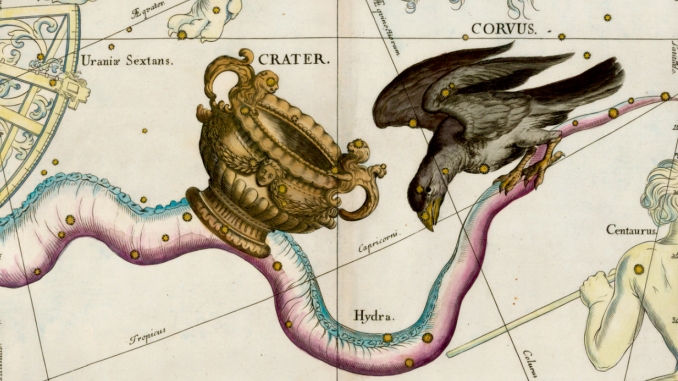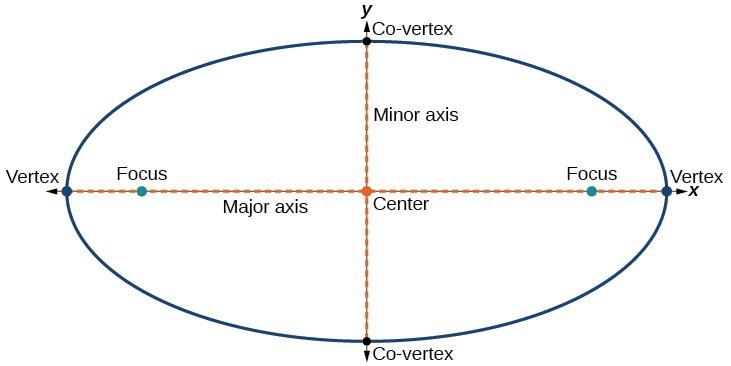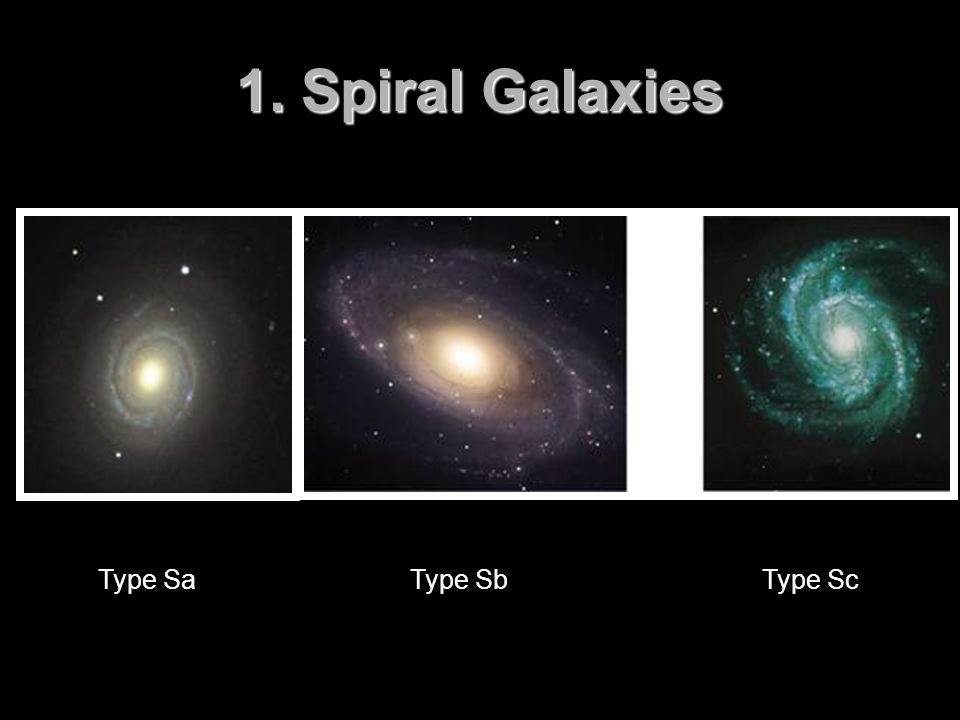
Corvus and Crater: Two tales of an unwise bird
By this time, those of you who've followed us on these mythological excursions know quite well that the Olympian gods, though far more powerful than mortals, tend to exhibit the basest mortal behaviors when in the throes of intense emotion or just because they can. Of course, in their defense, growing from infancy to maturity within three short days while nursed on vitamin-deficient ambrosia could severely diminish anyone's pre-frontal cortex development. Or, maybe, they were just raised in lofty abodes without consequences. The one Olympian notorious for his puerile antics and sky-splintering rages is Apollo, who, curiously, is the god of poetry, prophecy and healing. Both stories related to the constellation Corvus show Apollo at his ill-tempered worst. The first story pertains to Coronis, the enchantingly beautiful daughter of Phlyegas, king of Orchomenus and Cleophema, daughter of the Muse Erato. Apollo caught sight of Coronis one day and, having instantly fallen in love (or lust) with her, materialized before her and professed his feelings. Though her affection for him was limited, she yielded to his desires as she feared the consequences of rejecting a god. While she was pregnant with Apollo's child, Coronis fell in love with a mortal named Ischys. One afternoon, Corvus, Apollo's pet raven, saw Coronis and Ischys enjoying relations in a secret forest grove. Corvus flew to Olympus and told Apollo about Coronis' faithlessness. In a fury, Apollo kicked Corvus out of Olympus and scorched it. From that moment ravens, which had previously been white, all became black. Apollo then instructed his sister Artemis, goddess of the moon and hunt, to kill Coronis and her lover. Artemis dispatched them both with ruthless efficiency. As Coronis lay dying, Artemis took her unborn child from her and delivered him to Apollo. Feeling slight remorse for having ordered Coronis' death, Apollo commanded the wise centaur Chiron to raise the child, named Asclepius, to maturity. Coronis' son grew into one of the world's greatest healers. In another story, Apollo ordered Corvus, his pet crow, to fetch him a goblet filled with the freshest spring water. The crow took the goblet and sped down to Earth to collect the water. However, prior to reaching the spring, the crow encountered a fig tree that hadn't yet ripened. Corvus waited by the tree for a few days until the figs were ready to eat. The bird then engorged itself on figs until it could barely move. With immense difficulty, Corvus then flew to the spring and filled the goblet. When it returned to Olympus, the crow explained to Apollo that a water snake had guarded the spring and wouldn't allow Corvus near it. Only when the water snake left a few days later was Corvus able to access the water and bring it to Apollo. Unfortunately for Corvus, Apollo was the god of prophecy and knew full well the real reason for the crow's delay. Apollo kicked Corvus and the goblet out of Olympus and placed them in the sky along the top of Hydra, the many headed water snake. The crow was set just out of the goblet's reach so it wouldn't be able to drink water from it for all eternity: a punishment similar to that suffered by Tantalus. The crow turned black -and so did all the others- and became the constellation Corvus. The goblet was transformed into the constellation Crater.
THE SOUTHWORTH PLANETARIUM
207-780-4249 www.usm.maine.edu/planet
70 Falmouth Street Portland, Maine 04103
43.6667° N 70.2667° W
Altitude: 10 feet below sea level
Founded January 1970
Julian Date: 2459106.16
2020-2021: X
THE DAILY ASTRONOMER
Monday, September 14, 2020
Remote Planetarium 88: Hubble's "Tuning Fork"

Scientists classify specimens. This practise dates back to the very beginnings of what we now call "scientific inquiry." Astronomers are no different. They classify types of planets, stars and even specimens as enormous as galaxies. Today we focus on galactic classification: how are galaxies different? In which type of galaxy do we live? The image above shows one of astronomy's best known human constructs: Hubble's "Tuning Fork." Devised by American astronomer Edwin Hubble (1889-1953), this diagram divides galaxies according to their structures. The three main classifications are:
- Ellipticals
- Spirals
- Barred Spirals
Ellipticals
these galaxies are ellipsoidal in shape and lack any discernible interior structure such as one observes in spiral galaxies.
Spirals
galaxies in which the stars and other materials are concentrated within a series of spiral arms radiating away from the center.
Barred Spirals
spiral galaxies in which a bar composed of stars occupies the center.
Elliptical galaxies are further subdivided numerically. Elliptical galaxies are rated on a scale of 0 - 7 depending on the shape. Elliptical galaxies appearing nearly circular are classified as E0, whereas those that are highly elongated would be E7. The image below shows an example of both as well as an image of an E3 galaxy, one that is neither perfectly circular nor highly elongated:
.jpg%22&N=download (1).jpg)
One problem with this scheme relates to our perspective. A highly elongated elliptical galaxy could appear circular if viewed from one end. (Think of how a football wouldn't actually appear football-like if seen from a distance with the point directed toward you.)
________________________________________________
Mathematical aside: Ellipses and circles
Remember our discussion about planetary orbits? Yes, it's been awhile, hasn't it? Ok. Kepler's First Law states that every planetary orbit is an ellipse with the Sun at one focus.

An ellipse is a closed curve containing two foci. The straight line distance connecting one focus to any point on the curve and then back to the other focus is a constant. So, for instance, one could choose any point on the ellipse and then draw a straight line connecting each focus to it. This distance would be the same no matter where the point is located. The greater the distance between the foci, the more elongated the ellipse. If the foci occupy the same point, the ellipse is a circle in which all points are equidistant from a common center.
______________________________________________________
Spiral galaxies are subdivided by the letters a, b and c.
The designations pertain to the "tightness" of the spirals. Spiral galaxies that are tightly wound around the central bulge are Sa galaxy type; Spiral galaxies that are much more open are classified as Sc.

The image above shows three examples of Spiral galaxies. Notice that the arms within the Sa galaxy appear close together while the Sc galaxy's arms are more outspread.
Barred Spirals are subdivided in the same manner: a, b and c and for the same reason. A barred spiral with tightly bound arms is classified as Sba; those with more open arms are classified as Sbc. Examples of the three main barred spiral galaxy types are seen below.
.jpg%22&N=download (2).jpg)
The Milky Way Galaxy is classified as an Sbc or sometimes as a Sn(rs)bc, meaning that it is between a Sbb and Sbc. The (rs) indicates a ring of gas and stars around the central bar.
Tomorrow, we will expand our view to examine lenticular and irregular galaxies.